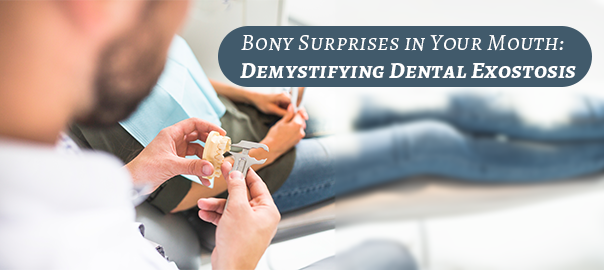
Bony Surprises in Your Mouth: Demystifying Dental Exostosis
Dental Exostosis: Understanding Bony Growths in Your Mouth
As dental professionals, we sometimes come across patients with unusual bony growths in their mouths. These growths, known as exostoses, often cause more concern than warranted. This blog aims to decode dental exostosis, exploring its symptoms, potential causes, and available treatments.
What is Dental Exostosis?
Dental exostosis refers to benign, bony outgrowths that develop in the mouth. These growths typically appear in three main forms:
1. Torus palatinus: A single growth on the roof of the mouth
2. Torus mandibularis: Bilateral growths beneath the tongue
3. Buccal exostoses: Less common protrusions on the outer gum surface
Symptoms and Identification
Exostoses often go unnoticed for years due to their slow growth. Common signs include:
– Hard, immovable lumps in the mouth
– Smooth or slightly rough texture
– Gradual increase in size over time
– Potential discomfort when eating certain foods
Potential Causes
The exact etiology of dental exostosis remains unclear. However, research published in the Journal of International Oral Health suggests several contributing factors:
– Genetic predisposition
– Environmental influences
– Excessive chewing or grinding (bruxism)
– Continued jawbone growth
When Treatment Becomes Necessary
In most cases, exostoses don’t require treatment. However, intervention may be necessary if:
– The growth interferes with speaking or eating
– Denture placement is compromised
– Recurrent soft tissue injuries occur
– The patient has significant aesthetic concerns
Treatment Options
When treatment is deemed necessary, surgical removal is the primary option. The procedure typically involves:
1. Local anesthesia administration
2. Incision and soft tissue elevation
3. Bone trimming using specialized dental instruments
4. Tissue reattachment and suturing
Advancements in dentistry have also allowed the use of lasers for its removal. This is becoming a potential alternative as it offers a less invasive approach in few cases.
Remember, maintaining excellent oral hygiene is crucial, especially if you have exostoses. Regular dental check-ups allow for monitoring of these growths and early intervention if needed. If you notice any unusual changes in your mouth, don’t hesitate to consult your dental professional.
Leave a Reply
Leave a Reply
Explore More Similar Posts
Explore More Blogs


Leave a Reply